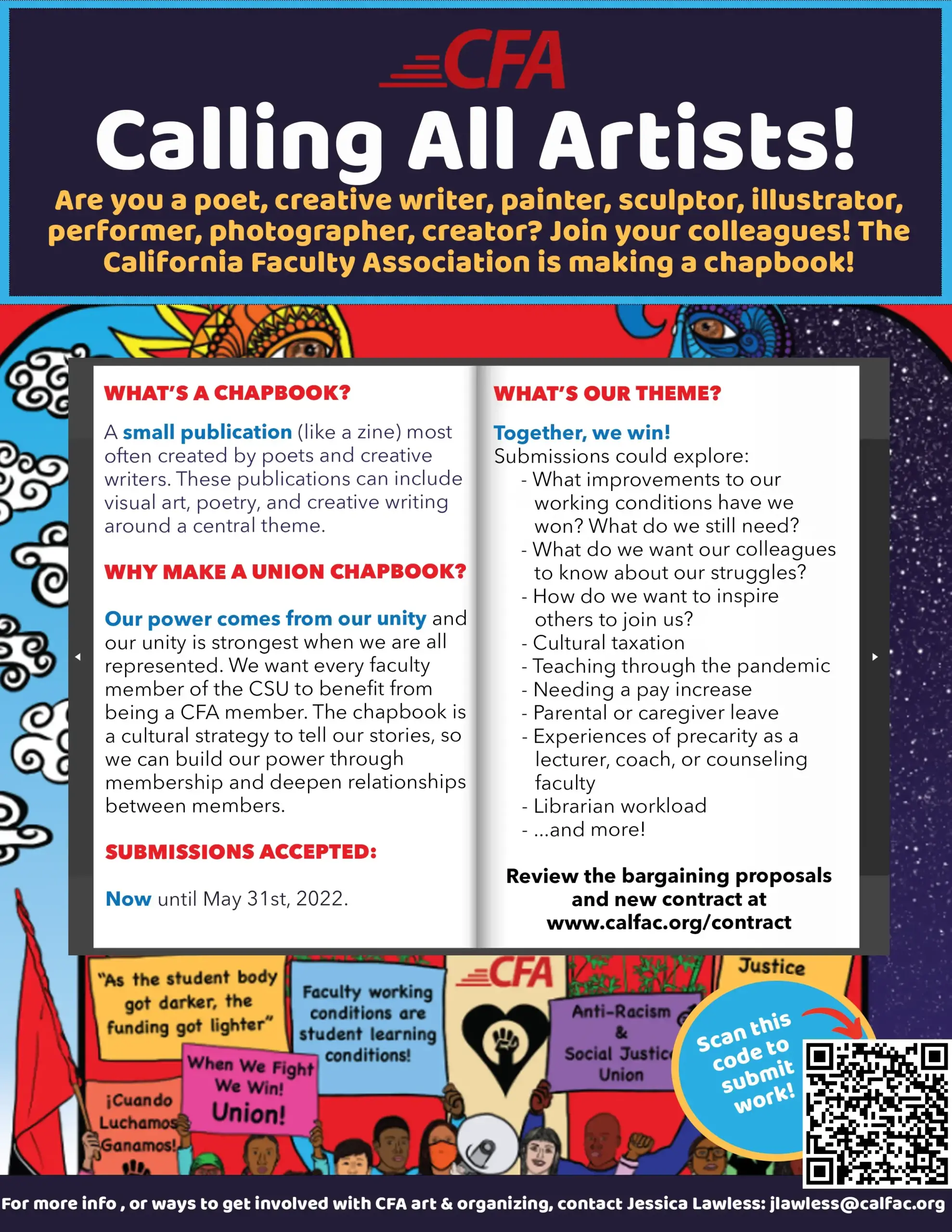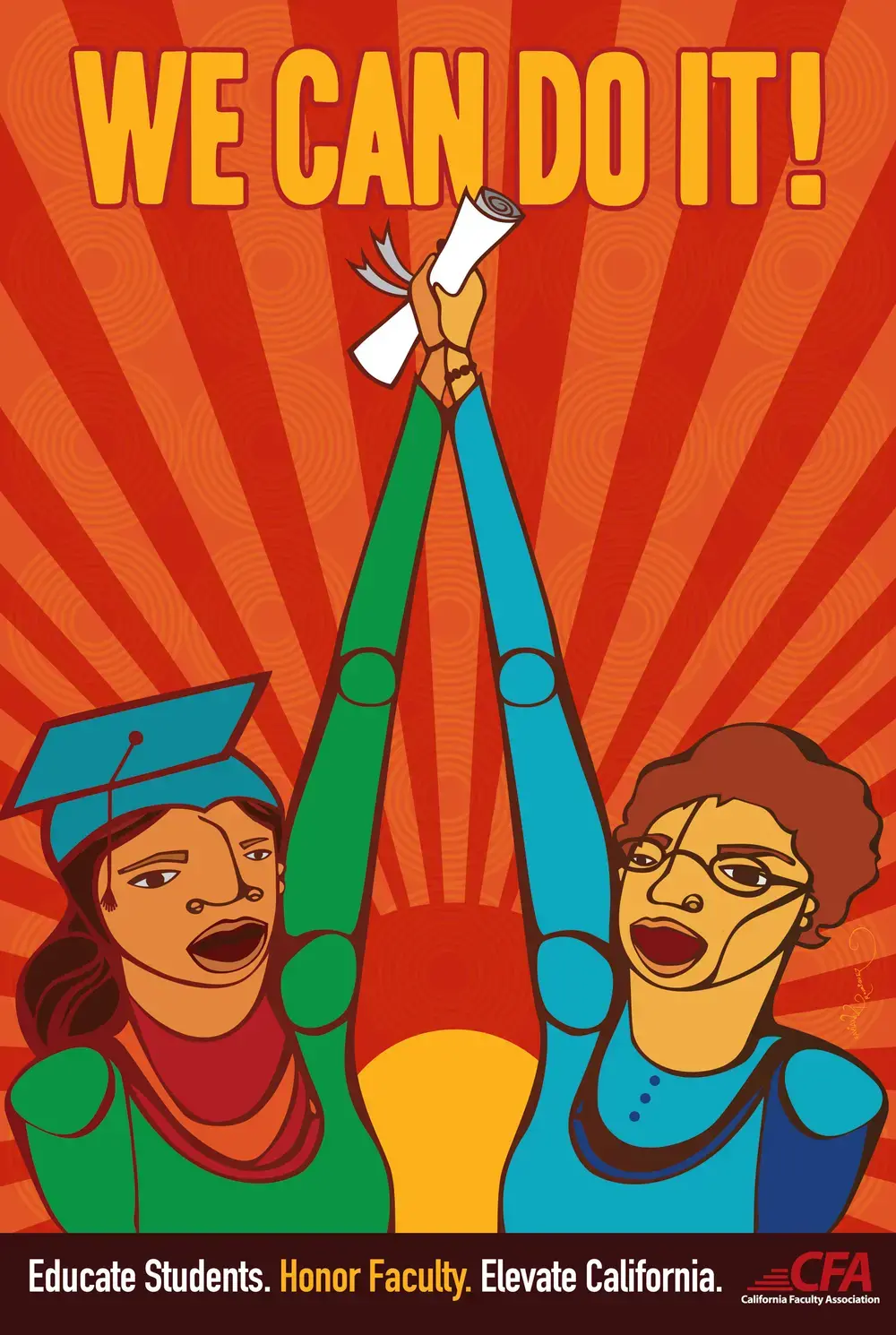CFA Members Celebrate Art, Creativity, Joy During Womxn’s History Month
Womxn and other marginalized genders have long used art and expression to spark joy, create sustenance, connect communities, and organize social movements.
Art is representation, belonging, spreading news beyond words. It’s a powerful form of storytelling and visualizing.
“Art is an expression of who we are, a celebration of the humanity in all of us, both individually and as a creative collective. Art requires one to be brave, to trust the process of innovation and to envision what is not there. At its root, art tells a story. It provides an emotional connection in creating engaging art that speaks to social issues of today,” said Leslie Bryan, CFA San Bernardino lecturers representative, CSU San Bernardino dance lecturer, and co-organizer of CFA’s chapbook.

“The work of CFA has always included an element of creativity in the telling of our story in visual, auditory and kinesthetic ways. We are now shifting to using art as an organizing tool and to help faculty find the artist within themselves and use this to push for effective racial and social justice. The art of our faculty will not only tell the stories of CFA’s successes but will also illustrate the need to effect change in the CSU,” Bryan added.
Envisioning a better, more just and inclusive future is a critical part of CFA members’ work educating tomorrow’s leaders and manifesting anti-racism and social justice unionism. Retired Sacramento State professor, CFA leader, and activist Dr. Cecil Canton highlighted the power of visualizing during this month’s Equity Conference.
“This is the story of the CFA dream and how the team came together to make the dream come true,” Canton said during his Dream Work Makes the Team Work session. “… And now we have dreams that are much bigger. I love that and I love that we’re evolving, and we keep dreaming, and we keep embracing because we’re embracing many, many more people.”

To facilitate envisioning a better CSU for faculty and students, CFA members are making a chapbook, a small self-produced publication, like a zine. Members can tell stories about their working conditions and the dreams they have for changing unjust oppressive systems through creative writing, poetry, short story, visual arts, photo documentation of actions and/or performances, digital graphics, and more. Focusing on the anti-racism, social justice organizing we do as a union, these stories will highlight underfunding mental health services, overfunding university police, lack of faculty diversity, undervaluing educators, and attempts to undermine academic freedom.
“Art is synonymous with activism. For years, in our outreach, campus events, conferences, and rallies, we have used art to convey our stories and create a stronger union. It was something we were doing, but we didn’t always name it as part of our work,” said Nicola Walters, CFA Membership & Organizing chair, Cal Poly Humboldt lecturer, and chapbook co-organizer. “Now, with the help of creative writers, photographers, sculptors, dancers, performers, painters, graphic designers, illustrators, and artists of all mediums across the CSU, we are building art into our organizing and exploring the potential of what we can create together.”
The CSU has history with art as resistance: Fresno State is one of the origin sites of the feminist art movement in the 1960s and 1970s. Founded by artist Judy Chicago, it was the first feminist art program in the nation.
Called the Feminist Art Program, the project was groundbreaking because it was an early location for female art students to learn the skills of becoming professional artists, and create together new forms of art making that expressed their experiences of being women, said Jill Fields, CFA Fresno member and history professor and founding coordinator of Jewish Studies at Fresno State.
There were multiple starting points in the feminist art movement in addition to Fresno State, such as the Black women’s art collective Where We At in New York and Las Mujeres Muralistas in the Bay Area, according to Fields, who edited “Entering the Picture” about how feminist art complemented the women’s movement and transformed America.
Better social relations require different thinking, and visual arts can serve to counter dominant culture narratives, she said, from Woody Guthrie’s “Union Maid” song to Picasso’s “Guernica” painting to Betye Saar’s assemblage “The Liberation of Aunt Jemima.”
“Creative expression can spark joy and community. It’s a different approach to imagining a more equitable present and future,” Fields said. “Art is a celebration of collective spirit, a medium to express loss, and a way to acknowledge feelings that are important elements of movements for social justice.”
Members can submit work to the CFA chapbook by May 31.
Join California Faculty Association
Join thousands of instructional faculty, librarians, counselors, and coaches to protect academic freedom, faculty rights, safe workplaces, higher education, student learning, and fight for racial and social justice.